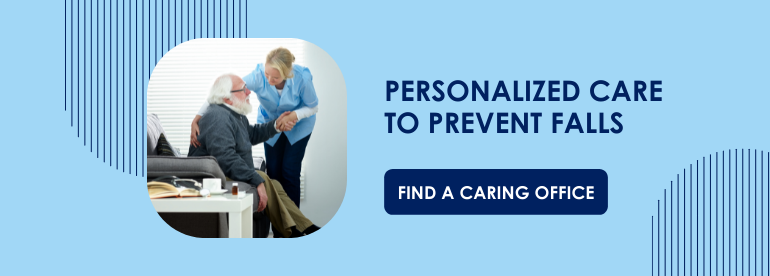Many of us are worried about checking our blood pressure to make sure it doesn’t get too high. But low blood pressure can also pose health risks, especially to seniors. Low blood pressure, or hypotension, can lead to fainting, dizzy spells, and dangerous falls.
Luckily, with proper precautions and treatment, older adults can remain safe and manage hypotension. Let’s explore some of the causes of low blood pressure and the risks associated with it.
Overview of Low Blood Pressure
Blood pressure is a measurement of the force that pushes blood throughout the body. Low blood pressure is considered anything lower than 90/60 mm Hg. Low blood pressure could indicate that the brain and limbs aren’t receiving adequate blood supply.
These are the most common types of low blood pressure.
- Postural hypotension or orthostatic hypotension: This type of low blood pressure happens suddenly after you move from lying down to sitting up. But it’s just due to changing positions and typically resolves quickly.
- Postprandial hypotension: This drop in blood pressure happens a few hours after eating. Seniors are especially prone to this type of hypotension. Eating smaller meals and drinking more water could help with this type of hypotension.
- Neurally mediated hypotension: This type of hypotension is a result of standing in place for long periods of time. It happens because of an abnormal reflex between the heart and the brain.
In addition to these types of hypotension, low blood pressure in seniors can also be caused by other factors, including:
- Low or high body temperature
- Excessive blood loss
- Severe dehydration
- Blood infections
- Allergic reaction
- Reactions to medication
- Health problems
- Nutritional deficiencies
RELATED CONTENT: Basics of Blood Pressure
Signs of Low Blood Pressure
You might not even know if you have low blood pressure. Just like with high blood pressure, the signs may not be noticeable at first. However, seniors with severe low blood pressure may experience the following symptoms:
- Dizziness
- Nausea
- Fainting
- Dehydration
- Blurry vision
- Fatigue
- Lack of concentration
- Cold, clammy, and pale skin
- Depression
If a senior experiences these symptoms, it’s a good idea to talk with a healthcare provider to identify and address the underlying cause.
Diagnosing and Treating Hypotension
To diagnose low blood pressure, your doctor may take several blood pressure readings over a period of time. Or, they may ask you to measure your blood pressure at home. This helps identify a pattern of low blood pressure.
Here’s a quick video to walk you through the process of home blood pressure monitoring:
Your doctor may also run blood tests, order a stress test, or have you get an electrocardiogram (ECF) or echocardiogram to see how the heart is functioning. If the doctor suspects orthostatic hypotension, they may have you do a tilt table test, which simulates the motion of lying down and standing up.
Once a senior has been diagnosed with low blood pressure, a doctor may recommend treatment options, including the following:
- Increase water consumption to help increase blood volume
- Reducing alcohol
- Wearing compression socks to promote blood flow in the legs
- Consume more salt, which helps the body retain water and increase blood pressure
- Exercise regularly
- Medication to help increase blood pressure
Risks of Low Blood Pressure
Low blood pressure can typically be managed with treatment, so seniors can continue to maintain their quality of life. However, if left untreated, low blood pressure can pose serious health risks to seniors.
- Dangerous Falls: The primary risk for seniors with low blood pressure is fall-related injury. A sudden drop in blood pressure can cause dizziness and fainting, which can both lead to falls. Seniors are already at a higher risk of falling due to loss of balance, muscle loss, and other factors. So low blood pressure just increases that risk. Falls can be life threatening, leading to fractures, sprains, and even fatalities.
- Shock: Extremely low blood pressure can lead to shock because organs are not getting the blood supply that they need. To help conserve blood and oxygen supply, organs may shut down, ultimately leading to permanent organ damage or death. When shock begins to set in, a senior may experience confusion, start breathing rapidly, and have a weak but rapid pulse.
- Heart problems: Low blood pressure can cause your heart to work overtime as it tries to pump faster and harder to get your blood pressure up. This extra work can cause permanent heart damage and even cause heart failure. Seniors may also be at risk for blood clots, which can lead to stroke or deep vein thrombosis.
RELATED CONTENT: Guide to Help Seniors Prevent Falls
Managing Low Blood Pressure
If you have been diagnosed with low blood pressure, the best thing you can do is follow your doctor’s orders and maintain a healthy lifestyle. If you start to feel dizzy or lightheaded, sit down and take a break! There’s no need to rush and put yourself at risk of a dangerous fall.
Home care can also help seniors manage low blood pressure. Caregivers can provide a steady hand to help keep seniors stable when they stand up after sitting or lying down for long periods of time. They can also help seniors manage their medications, eat healthily, drink plenty of water, and follow through on other aspects of their treatment plan.
If you or a loved one needs assistance managing low blood pressure at home, reach out to your local Caring team.


